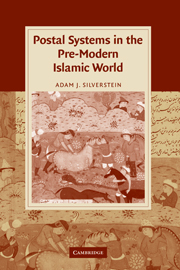Book contents
- Frontmatter
- Contents
- List of maps
- Acknowledgements
- List of abbreviations
- Introduction
- PART I THE PRE-ISLAMIC BACKGROUND
- PART II CONQUEST AND CENTRALISATION – THE ARABS
- PART III CONQUEST AND CENTRALISATION – THE MONGOLS
- 4 The Mongol Yām and its legacy
- 5 The Mamluk Barīd
- Conclusions
- Appendix: distances and speeds of the Barīd
- Bibliography
- Index
- Cambridge Studies in Islamic Civilization
4 - The Mongol Yām and its legacy
Published online by Cambridge University Press: 18 July 2009
- Frontmatter
- Contents
- List of maps
- Acknowledgements
- List of abbreviations
- Introduction
- PART I THE PRE-ISLAMIC BACKGROUND
- PART II CONQUEST AND CENTRALISATION – THE ARABS
- PART III CONQUEST AND CENTRALISATION – THE MONGOLS
- 4 The Mongol Yām and its legacy
- 5 The Mamluk Barīd
- Conclusions
- Appendix: distances and speeds of the Barīd
- Bibliography
- Index
- Cambridge Studies in Islamic Civilization
Summary
Introduction
Bearing in mind the roles that merchants played in the transmission of news in Near Eastern history, we should not be surprised that the Khwārazm-shāh's governor of Utrār suspected a delegation from Chinggis Khān of espionage, and putting enemy spies to death would have shocked few in the pre-modern world. Unfortunately for the Khwārazm-shāh ‘it was the custom of the Tartars never to make peace with those who have killed their envoys until they have wrought vengeance upon them’, as one medieval observer put it. In the interest (or with the pretext) of revenge for the massacre of the Mongol merchants and envoys, Chinggis Khān and his successors embarked on a devastating campaign of conquest through Central Asia. Amongst the numerous consequences of these conquests and of the establishment of a Mongol polity in their wake, the one relevant to this study is the creation of a postal system that both provided communications during the conquests and facilitated imperial administration in their aftermath.
The Mongol postal system, usually referred to as the Yām, is generally agreed to have been adopted from the Chinese Yi (or Li) system of communication, which was introduced to Chinggis through the Uighur and Khitan advisors who had a formative influence on the development of Mongol bureaucratic practices and institutions. Prominent examples of such functionaries include Tʾa-Tʾa-Tungʾa, Chinggis' Uighur secretary, and Chinkai, the Nestorian Kereit advisor to Chinggis, Ögödei, and Güyüg, who established the Mongols' chancery.
- Type
- Chapter
- Information
- Postal Systems in the Pre-Modern Islamic World , pp. 141 - 164Publisher: Cambridge University PressPrint publication year: 2007



